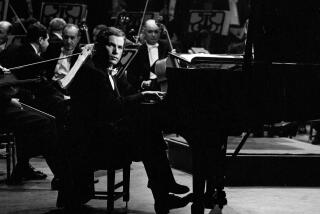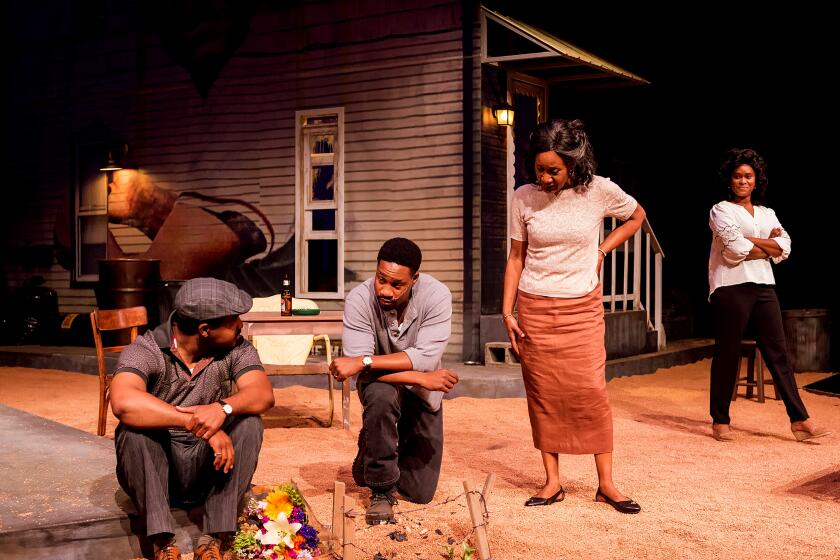Piotr Anderszewski at Disney Hall
The performance history of Bach on the piano is a back-and-forth business. We go through cycles of interpretive restraint and freedom. Not long ago pianists, needing to get out from under the shadow of Glenn Gould’s brilliantly unpredictable Bach, wanted to return to only the notes and the laws of counterpoint as a counterpart to atoms and the laws of physics. Revelation, this school believes, will follow of its own accord.
The pendulum has now swung back to giving Bach a helping hand. Piotr Anderszewski, a slender 39-year-old Polish pianist with a spine-tingling technique, devoted his recital Saturday night at Walt Disney Concert Hall to Bach. He played with pin-prick accuracy. He wasn’t unaware of history. But he wasn’t unaware either of the Romantic era or the gains and pitfalls of period practice. He knows his Gould, and he knows his own era.
Actually, Anderszewski appears a slight anachronism; his fashion sense is that of a 1960s British rocker, a mop-top Bachian. He exudes romantic cool, showy but unflappable. His tone is incandescent. He enjoys a good surprise, and there were many all evening.
Mainly this was Bach as relevant drama and very much Bach as piano music. The first half of the program was devoted to the first two of the composer’s six partitas, played in reverse order. These are some of Bach’s flashier keyboard dances, and Anderszewski is not one to let a flourish of the fingers go by unnoticed. But he also has a larger, more interesting agenda.
He toyed with extreme dynamic contrasts, which is something he pretty much made up himself, given that the harpsichord, for which this music was written, is a plucked instrument, limited in its ability to exploit extremes of loud and soft. In the Courante movement of the Second Partita, he maintained tense accelerations in rhythmic figures that created a kind of dynamic Bach for the age of John Adams. The Rondeaux was pop-up Bach, each quick note a small explosion.
In the First Partita, two minuet movements became a ballroom scene, starchy music made into a fluid study in various forms of seduction. Though an animated pianist, Anderszewski also displays an attractive penchant for exquisite lyricism. Slow, seamless sarabandes in both partitas moved out of Bach’s world and into Chopin’s.
In the second half of the program, Anderszewski began with the two preludes and fugues (in A major and minor) from Book II of “The Well-Tempered Clavier” and concluded with the English Suite No. 6, which was treated as the most modern Bach of all.
I heard this performance as a parade of time. Extreme clarity of line served Bach’s counterpoint very well. But glamorous fingerwork beginning the Prelude proved a potent theatrical gesture. Pumping out the bass in the Allemande was Bach for rockers. The Sarabande was very, very slow and very, very beautiful pianistic stargazing, almost like something out of Bartók. The Gavottes stood out as the exaggeration of old manners, English court life as seen in a wide-screen costume drama. The Gigue was as if infected by mad insect.
Anderszewski had an extraordinary and substantial encore, Beethoven’s late set of Bagatelles, Opus 126.
There is a hint of Beethoven at the end of his life looking back at Bach in these short movements. Beethoven’s feet barely touch the ground here, nor did Anderszewski’s, who reminded us with the bagatelles that he came to fame for his captivating recording of Beethoven’s “Diabelli” Variations eight years ago.
Anderszewski’s Bach clearly goes with everything, and coincidentally he had an unwitting collaborator in another Eastern European pianist three nights earlier at Disney. András Schiff, who came to fame with his Bach recordings, ended his Beethoven sonata recital with an extraordinary and substantial encore -- Bach’s “Italian” Concerto.
More to Read
The biggest entertainment stories
Get our big stories about Hollywood, film, television, music, arts, culture and more right in your inbox as soon as they publish.
You may occasionally receive promotional content from the Los Angeles Times.







